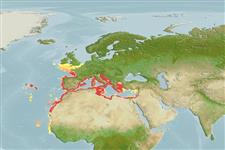Common names from other countries
Environment: milieu / climate zone / depth range / distribution range
Ecologia
; intervalo de profundidade 0 - 444 m (Ref. 101469), usually 4 - 50 m (Ref. 4). Subtropical; 52°N - 10°N, 33°W - 37°E (Ref. 4)
Eastern Atlantic and the Mediterranean: Off Madeira, the Canary Islands and along the Atlantic coast of Morocco as far south as Agadir; the Azores, throughout the Mediterranean (but not in the Black Sea) and along the Atlantic coast of Europe to the English Channel.
Length at first maturity / Tamanho / Peso / Idade
Maturity: Lm ? range ? - ? cm Max length : 16.0 cm BL macho/indeterminado; (Ref. 4); common length : 10.0 cm BL macho/indeterminado; (Ref. 4)
Carapace with 3 distinct acute teeth in the median line before the cervical groove (the gastric, pregastric and rostral teeth). Region between the postrostral and branchial carinae with only a few tubercles, and with extensive smooth areas. Abdomen without a sharp median ridge, but each of somites 2 to 5 with an elongate lobulate figure in the middle. The exposed part of somites 2 to 5 with an arborescent arrangement of very narrow grooves. Somite 1 with a complete transverse groove, behind which there are numerous short longitudinal grooves that are rather irregular in shape, may divide and sometimes are interconnected by transverse grooves; this posterior half of somite 1 of equal length throughout its width, not longer in the middle that at the sides. The smooth anterior half of the abdominal somites 2 to 6 (i.e. the part of the somite that disappears under the previous somite when the abdomen is fully stretched) without any indication of grooves or rows of hairs. Fourth segment of antenna with a single oblique median carina. Outer margin of the segment with 2 teeth, the inner margin with 3 or 4 (not including the apical tooth). Thoracic sternum anteriorly V-shapedly incised in the middle. A blunt and low median tubercle on the last thoracic sternite; this tubercle somewhat flattened posteriorly. Dactyli of legs without fringes of hair. Color: Reddish brown with a dark brown pubescence; A dark brown, not sharply delimited spot in the center part of the abdominal somite 1; Segments of the pereiopods with a dark blue band each.
Life cycle and mating behavior
Maturidade | Reprodução | Desova | Ovos | Fecundidade | Larvas
Ovigerous females from February to April.
Holthuis, L.B. 1991. (Ref. 4)
Categoria na Lista Vermelha da IUCN (Ref. 130435: Version 2024-1)
Categoria CITES (Ref. 108899)
Not Evaluated
Not Evaluated
Utilização humana
Pescarias: pouco comercial
| FishSource | Sea Around Us
Ferramentas
Mais informação
Idade/TamanhoCrescimentoComprimento-pesoComprimento-comprimentoMorfologiaLarvasAbundância
Fontes da internet
Estimates based on models
Preferred temperature
(Ref.
115969): 14.4 - 21.4, mean 18.3 (based on 298 cells).
Vulnerabilidade
Low vulnerability (10 of 100).
